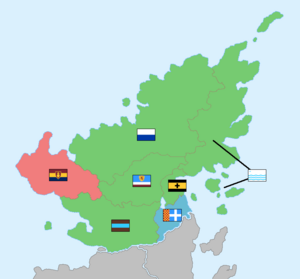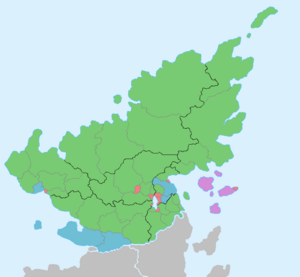Administrative divisions of Seketan
 |
|---|
| This article is part of a series on the politics and government of Seketan |
The administrative divisions of Seketan are the various units of government that are responsible for regional and local governance. A unitary state, Seketan is divided into provinces and municipalities, with further city and town boundaries forming local governments. Official regions are defined by the government for historical and statistical purposes.
Seketan is broadly decentralized and divisions in Seketan are unequal in their authority and responsibilities. The provinces of Fjeska and Wilskland are specified in the constitution, both carrying various degrees of autonomy. Various municipalities in Seketan have special status as city municipalities. Subdivisions from all levels have adopted official languages apart from Seketese including Wilsk, Fjeskan, Trjebian, Svealandic, as well as various Seketese dialects with separate written standards.
Provinces
Seketan is made up of 7 primary divisions, collectively known as provinces. Five (Bynan, Ellinesa, Giorgi-Alesk, Gjenor, and Nelderjen) are provinces, one (Wilskland) is an independent state, and one (Fjeska) is an autonomous province. According the Constitution of Seketan all provinces are equal, with each having the same devolved powers, however in practice Wilskland is often afforded certain powers due to their unique history with Seketan. Fjeska is also afforded special powers outside the constitution, authorized in the Fjeskan conflict, specifically over language and education.
All provinces operate under some form of a semi-parliamentary system. The 5 provinces and Wilskland hold elections every 4 years to elect provincial assemblies. The largest party or coalition of parties forms a government and nominates someone to be the Chief of Government (or First Minister in Wilskland). Unlike most parliamentary systems, responsible government is not exercised, meaning that early elections cannot be called, ergo if a majority coalition cannot be created, the largest party will form a minority government by default. For crucial measures like budgets, the most recently passed version is used continuously until a new one is passed.
Under the Loria Accords, Fjeska is officially an Autonomous Province with a Consociational devolved legislature. Each election takes place separately in the Seketese and Fjeskan zone, with the governing coalition needing a majority of seats in each zone to form a government. In the event that an agreement cannot be reached, the National government will appoint a non-partisan government until one can be reached.
List
| Flag | Province | Population | Largest city | Languages |
|---|---|---|---|---|
| Gjenor | 1,141,500 | Conelibek | Seketese | |
| Wilskland | 1,079,393 | Fyedor | Wilsk | |
| Nelderjen | 988,047 | Winneston | Seketese | |
| Fjeska | 912,250 | Loria | Seketese, Fjeskan | |
| Bynan | 752,608 | Fevilla | Seketese, Trjeban | |
| Ellinesa | 604,095 | Porta | Seketese | |
| Giorgi-Alesk | 94,850 | Alitz | Seketese, Wilsk |
Municipalities
| Type | # | Powers | Largest division | ||||
|---|---|---|---|---|---|---|---|
| Can tax? | Create Cities? | Elects Executive? | Elects Council? | Police Force? | |||
| District | 34 | Afinytan, Fjeska (39,572) | |||||
| City-Municipality | 10 | Conelibek, Gjenor (827,193) | |||||
| Region | 5 | Walynen, Gjenor (149,970) | |||||
| Community | 1 | Ellinesa Islands, Ellinesa (182,798) | |||||
Seketan is divided up into 50 municipalities, consisting of 34 districts, 10 city-municipalities, 5 regions, and 1 community. Under the constitution of Seektan, municipalities are the sole responsibility of the national government, with the provinces having no control over their affairs. Each type of municipality is laid out in the Local Associations Act with the following powers and responsibilities:
The national government is authorized to create, reclassify, or amend municipalities and their powers at any time, with only some consultation required. Only in city-municipalities is the national government required to hold a plebiscite if they wish to amend their powers or reclassify the city. This high amount of power of local municipalities has often caused tension between the national and local level, such as when Prime Minister Tomas Serdoa attempted to reform the entire municipal structure and amalgamate several districts into large city-municipalities. He was ultimately only successful in Aalitonja, but had elevated a few districts into regions such as Becjonyn and Sjedytan.
Communities were created in 2011 to accommodate the Ellinesan islands. By 2008, all of the various islands lands had been annexed into some city, leaving no unincorporated area. It is by far the least powerful municipality type, with virtually all of the local powers being dealt to the local governments.
Local government areas
Within districts, regions, and communities, local government areas can be created by the municipal government with the ability to elect their own city councils and mayors, alongside to city-municipalities. Currently there are 30 local cities, with the largest being Ylinc, Walycesa, Wilskland with a population of 177,294.
Regions
Seketan is divided into regions both officially and unofficially for various purposes. The Seketese government defines six official statistical regions: Central, Western, Southern, Northern, Eastern Seketan, and Wilskland.
- Western Seketan
- Central Seketan
- Eastern Seketan
- Southern Seketan
- Northern Seketan
- Northern Trjebia
- Wilskia

